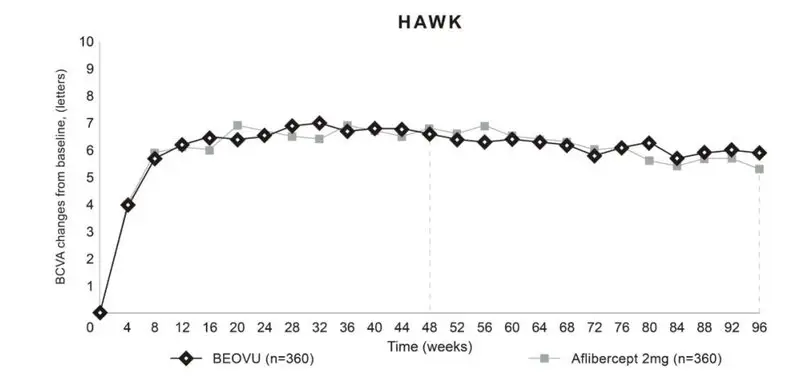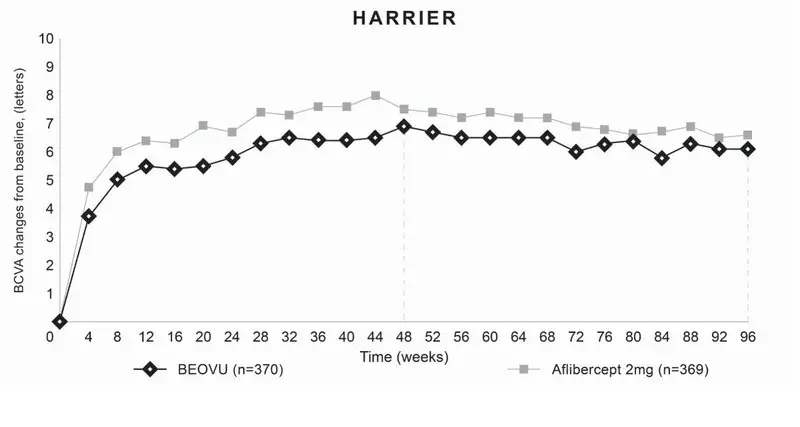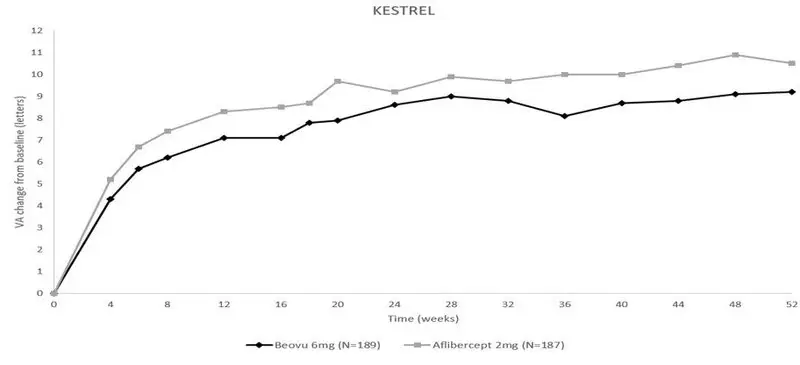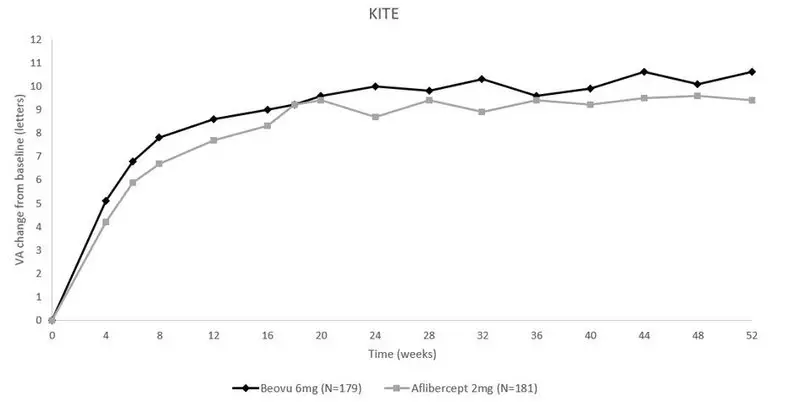Drug Detail:Beovu (Brolucizumab-dbll)
Drug Class: Anti-angiogenic ophthalmic agents
Highlights of Prescribing Information
BEOVU® (brolucizumab-dbll) injection, for intravitreal use
Initial U.S. Approval: 2019
Recent Major Changes
| Indications and Usage, Diabetic Macular Edema (DME) (1.2) | 5/2022 |
| Dosage and Administration, General Dosing Information (2.1) | 3/2022 |
| Dosage and Administration, Diabetic Macular Edema (DME) (2.3) | 5/2022 |
| Dosage and Administration, Preparation for Administration – Pre-filled Syringe and Vial (2.4) | 3/2022 |
| Dosage and Administration, Injection Procedure (2.5) | 5/2022 |
| Warnings and Precautions, Retinal Vasculitis and/or Retinal Vascular Occlusion (5.2) | 2/2022 |
Indications and Usage for Beovu Injection
BEOVU is a human vascular endothelial growth factor (VEGF) inhibitor indicated for the treatment of:
- Neovascular (Wet) Age-Related Macular Degeneration (AMD) (1.1)
- Diabetic Macular Edema (DME) (1.2)
Beovu Injection Dosage and Administration
Neovascular (Wet) Age-Related Macular Degeneration (AMD)
- The recommended dose for BEOVU is 6 mg (0.05 mL of 120 mg/mL solution) monthly (approximately every 25-31 days) for the first three doses, followed by one dose of 6 mg (0.05 mL) every 8-12 weeks (2.2).
Diabetic Macular Edema (DME)
- The recommended dose for BEOVU is 6 mg (0.05 mL of 120 mg/mL solution) every six weeks (approximately every 39-45 days) for the first five doses, followed by one dose of 6 mg (0.05 mL of 120 mg/mL solution) every 8-12 weeks (2.3).
Dosage Forms and Strengths
- Intravitreal injection: 6 mg/0.05 mL solution in a single-dose pre-filled syringe (3).
- Intravitreal injection: 6 mg/0.05 mL solution in a single-dose vial (3).
Contraindications
- Ocular or Periocular Infections (4.1)
- Active Intraocular Inflammation (4.2)
- Hypersensitivity (4.3)
Warnings and Precautions
- Endophthalmitis and retinal detachment may occur following intravitreal injections. Patients should be instructed to report any symptoms suggestive of endophthalmitis or retinal detachment without delay (5.1).
- Retinal vasculitis and/or retinal vascular occlusion, typically in the presence of intraocular inflammation, have been reported following BEOVU injections. Patients should be instructed to report any change in vision without delay (5.2).
- Increases in intraocular pressure (IOP) have been seen within 30 minutes of an intravitreal injection (5.3).
- There is a potential risk of arterial thromboembolic events (ATE) following intravitreal use of VEGF inhibitors (5.4).
Adverse Reactions/Side Effects
The most common adverse reactions reported in patients receiving BEOVU are vision blurred, cataract, conjunctival hemorrhage, eye pain, and vitreous floaters (6.1).
To report SUSPECTED ADVERSE REACTIONS, contact Novartis Pharmaceuticals Corporation at 1-888-669-6682 or FDA at 1-800-FDA-1088 or www.fda.gov/medwatch.
See 17 for PATIENT COUNSELING INFORMATION.
Revised: 12/2022
Full Prescribing Information
2. Beovu Injection Dosage and Administration
2.1 General Dosing Information
For ophthalmic intravitreal injection. BEOVU must be administered by a qualified physician.
BEOVU is available packaged as follows [see How Supplied/Storage and Handling (16)]:
- Pre-filled Syringe
- Vial kit with injection components (vial, filter needle)
2.2 Neovascular (Wet) Age-Related Macular Degeneration (AMD)
The recommended dose for BEOVU is 6 mg (0.05 mL of 120 mg/mL solution) administered by intravitreal injection monthly (approximately every 25 to 31 days) for the first three doses, followed by 6 mg (0.05 mL) by intravitreal injection once every 8 to 12 weeks.
2.3 Diabetic Macular Edema (DME)
The recommended dose for BEOVU is 6 mg (0.05 mL of 120 mg/mL solution) administered by intravitreal injection every six weeks (approximately every 39-45 days) for the first five doses, followed by 6 mg (0.05 mL) by intravitreal injection once every 8-12 weeks.
2.4 Preparation for Administration – Pre-filled Syringe and Vial
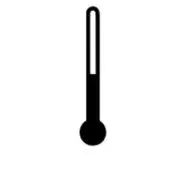 | Store BEOVU in the refrigerator between 2°C to 8°C (36°F to 46°F); do not freeze. Keep BEOVU in the outer carton to protect from light. |
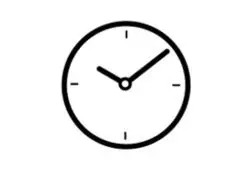 | Prior to use, the unopened glass vial or sealed blister pack of BEOVU may be kept at room temperature, 20°C to 25°C (68°F to 77°F) for up to 24 hours. After opening, proceed under aseptic conditions. |
| BEOVU is a clear to slightly opalescent and colorless to slightly brownish-yellow solution. | |
![Preparation for Administration - BEOVU should be inspected visually upon removal from the refrigerator and prior to administration. If particulates, cloudiness, or discoloration are visible, the glass vial must not be used. The BEOVU kit includes the sterile glass vial and filter needle which are for single use only. Do not use if the packaging, vial and/or filter needle are damaged or expired [see How Supplied/Storage and Handling (16)].](https://cdn.themeditary.com/images/2023/09/02/rth258-04.webp) | BEOVU should be inspected visually upon removal from the refrigerator and prior to administration. If particulates, cloudiness, or discoloration are visible, the BEOVU must not be used. |
Use aseptic technique for preparation of the intravitreal injection.
Pre-filled Syringe
The BEOVU pre-filled glass syringe is sterile and for single-use only. It should be inspected visually prior to administration. Do not use if the packaging, or pre-filled syringe are opened, damaged or expired [see How Supplied/Storage and Handling (16)].
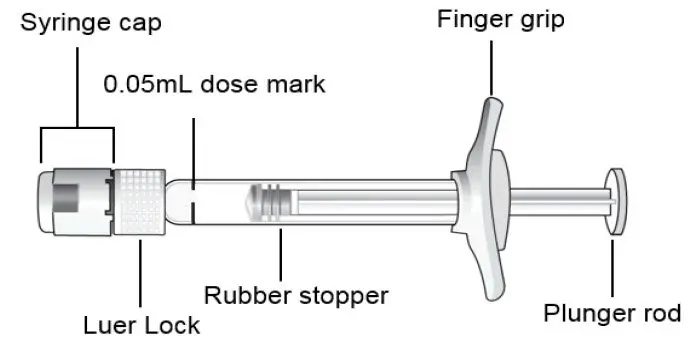
| STEP 1: PREPARE
Peel the lid off the blister package and, using aseptic technique, remove the sterile syringe. | |
| STEP 2: SNAP OFF SYRINGE CAP
Snap off the syringe cap and dispose of it (see Figure 1). Do not turn or twist the syringe cap. | Figure 1:
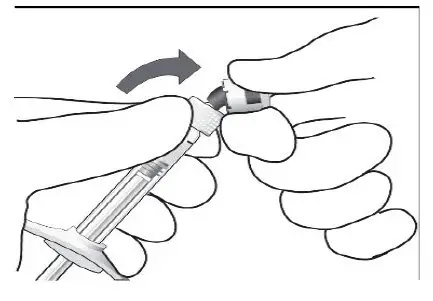 |
| STEP 3: ATTACH INJECTION NEEDLE
Aseptically and firmly assemble a 30-gauge x ½ inch sterile injection needle (not included) onto the Luer lock syringe. | |
| STEP 4: DISLODGE AIR BUBBLES
To check for air bubbles, hold the syringe with the needle pointing up. If there are any air bubbles, gently tap the syringe with your finger until the bubbles rise to the top (see Figure 2). Carefully remove the needle cap by pulling it straight off. | Figure 2:
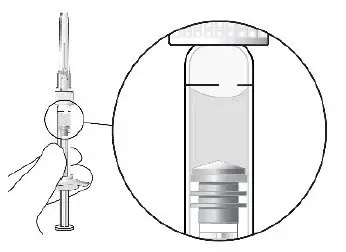 |
| STEP 5: EXPEL AIR AND SET THE DOSE
Hold the syringe at eye level and carefully push the plunger until the edge below the dome of the rubber stopper is aligned with the 0.05 mL dose mark (see Figure 3). This will expel the air and the excess liquid and set the dose to the 0.05 mL dose mark. The syringe is ready for the injection. | Figure 3:
 |
Vial
The BEOVU vial kit includes the sterile glass vial and filter needle which are sterile and for single-use only. It should be inspected visually prior to administration. Do not use if the packaging, vial and/or filter needle are damaged or expired [see How Supplied/Storage and Handling (16)].
STEP 1: Gather the supplies needed.
| |
| STEP 2:
Inspect the solution. If particulates, cloudiness, or discoloration are visible, discard the vial and obtain a new vial. | |
| STEP 3:
Remove the vial cap and clean the vial septum (e.g., with alcohol swab) (see Figure 4). | Figure 4:
 |
| STEP 4:
Assemble the 5-micron filter needle (18-gauge x 1½ inch) onto a 1-mL syringe using aseptic technique. | |
| STEP 5:
Push the filter needle into the center of the vial septum until the needle touches the bottom of the vial. | |
| STEP 6:
To withdraw the liquid, hold the vial slightly inclined and slowly withdraw all the liquid from the vial and filter needle (see Figure 5). Ensure that the plunger rod is drawn sufficiently back when emptying the vial in order to completely empty the filter needle. | Figure 5:
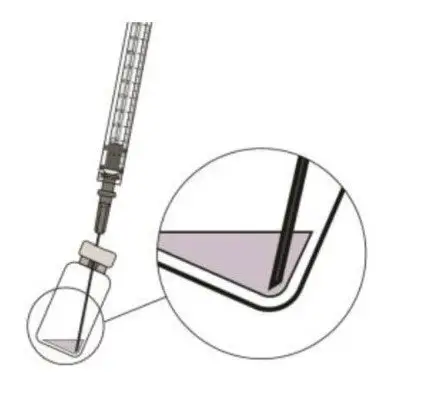 |
| STEP 7:
Disconnect the filter needle from the syringe in an aseptic manner and dispose of it. The filter needle is not to be used for the intravitreal injection. | |
| STEP 8:
Aseptically and firmly assemble a 30-gauge x ½ inch injection needle onto the syringe. | |
| STEP 9:
Check for air bubbles by holding the syringe with the needle pointing up. If there are any air bubbles, gently tap the syringe with your finger until the bubbles rise to the top (see Figure 6). | Figure 6:
 |
| STEP 10:
Carefully expel the air from the syringe and adjust the dose to the 0.05 mL mark (see Figure 7). The syringe is ready for the injection. | Figure 7:
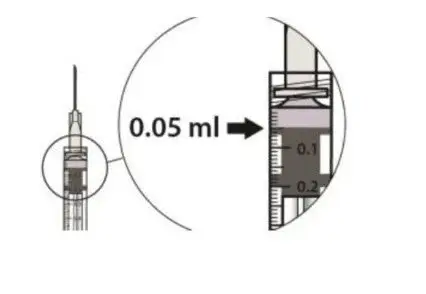 |
2.5 Injection Procedure
Ensure that the injection is given immediately after preparation of the dose.
The intravitreal injection procedure must be carried out under aseptic conditions, which includes the use of surgical hand disinfection, sterile gloves, a sterile drape and a sterile eyelid speculum (or equivalent), and the availability of sterile paracentesis equipment (if required). Adequate anesthesia and a broad-spectrum topical microbicide to disinfect the periocular skin, eyelid, and ocular surface should be administered prior to the injection.
Inject slowly until the rubber stopper reaches the end of the syringe to deliver the volume of 0.05 mL. Confirm delivery of the full dose by checking that the rubber stopper has reached the end of the syringe barrel.
Immediately following the intravitreal injection, patients should be monitored for elevation in intraocular pressure (IOP). Appropriate monitoring may consist of a check for perfusion of the optic nerve head or tonometry. If required, a sterile paracentesis needle should be available.
Following intravitreal injection, patients should be instructed to report any symptoms suggestive of endophthalmitis or retinal detachment (e.g., eye pain, redness of the eye, photophobia, blurring of vision) without delay [see Patient Counseling Information (17)].
Each vial or pre-filled syringe should only be used for the treatment of a single eye. If the contralateral eye requires treatment, a new vial or pre-filled syringe should be used and the sterile field, syringe, gloves, drapes, eyelid speculum, filter, and injection needles should be changed before BEOVU is administered to the other eye.
Any unused medicinal product or waste material should be disposed of in accordance with local regulations.
3. Dosage Forms and Strengths
BEOVU is a clear to slightly opalescent and colorless to slightly brownish-yellow solution available as:
- Intravitreal injection: 6 mg/0.05 mL in a single-dose pre-filled syringe.
- Intravitreal injection: 6 mg/0.05 mL in a single-dose vial.
4. Contraindications
4.1 Ocular or Periocular Infections
BEOVU is contraindicated in patients with ocular or periocular infections.
5. Warnings and Precautions
5.1 Endophthalmitis and Retinal Detachment
Intravitreal injections, including those with BEOVU, have been associated with endophthalmitis and retinal detachment [see Contraindications (4.1) and Adverse Reactions (6.1)]. Proper aseptic injection techniques must always be used when administering BEOVU. Patients should be instructed to report any symptoms suggestive of endophthalmitis or retinal detachment without delay and should be managed appropriately [see Dosage and Administration (2.4) and Patient Counseling Information (17)].
5.2 Retinal Vasculitis and/or Retinal Vascular Occlusion
Retinal vasculitis and/or retinal vascular occlusion, typically in the presence of intraocular inflammation, have been reported with the use of BEOVU. These immune-mediated adverse events may occur following the first intravitreal injection. Discontinue treatment with BEOVU in patients who develop these events. Patients treated with BEOVU who experience intraocular inflammation may be at risk of developing retinal vasculitis and/or retinal vascular occlusion and should be closely monitored [see Contraindications (4.2) and Adverse Reactions (6.1, 6.2)]. Patients should be instructed to report any change in vision without delay.
5.3 Increase in Intraocular Pressure
Acute increases in intraocular pressure (IOP) have been seen within 30 minutes of intravitreal injection, including with BEOVU [see Adverse Reactions (6.1)]. Sustained IOP increases have also been reported. Both IOP and perfusion of the optic nerve head must be monitored and managed appropriately [see Dosage and Administration (2.4)].
5.4 Thromboembolic Events
Although there was a low rate of arterial thromboembolic events (ATEs) observed in the BEOVU clinical trials, there is a potential risk of ATEs following intravitreal use of VEGF inhibitors. Arterial thromboembolic events are defined as nonfatal stroke, nonfatal myocardial infarction, or vascular death (including deaths of unknown cause).
The ATE rate in the two controlled 96-week neovascular AMD studies (HAWK and HARRIER) during the first 96-weeks was 4.5% (33 of 730) in the pooled brolucizumab arms compared with 4.7% (34 of 729) in the pooled aflibercept arms [see Clinical Studies (14.1)].
6. Adverse Reactions/Side Effects
The following potentially serious adverse reactions are described elsewhere in the labeling:
- Hypersensitivity [see Contraindications (4.3)]
- Endophthalmitis and Retinal Detachment [see Warnings and Precautions (5.1)]
- Retinal Vasculitis and/or Retinal Vascular Occlusion [see Warnings and Precautions (5.2)]
- Increase in Intraocular Pressure [see Warnings and Precautions (5.3)]
- Thromboembolic Events [see Warnings and Precautions (5.4)]
6.1 Clinical Trials Experience
Because clinical trials are conducted under widely varying conditions, adverse reaction rates observed in one clinical trial of a drug cannot be directly compared with rates in the clinical trials of the same or another drug and may not reflect the rates observed in practice.
A total of 1,646 patients treated with brolucizumab constituted the safety population in four Phase 3 studies. Among these, 1,098 patients were treated with the recommended dose of 6 mg.
A total of 1088 patients treated with brolucizumab, constituted the safety population in the two controlled neovascular AMD Phase 3 studies (HAWK and HARRIER) with a cumulative 96-week exposure to BEOVU, and 730 patients treated with the recommended dose of 6 mg [see Clinical Studies (14.1)]. A total of 558 patients treated with brolucizumab constituted the safety population in the two controlled DME Phase 3 studies (KESTREL and KITE) from baseline to week 52, including 368 patients treated with the recommended dose of 6 mg [see Clinical Studies (14.2)].
| aIncluding vision blurred, visual acuity reduced, visual acuity reduced transiently, and visual impairment. bIncluding anterior chamber cell, anterior chamber flare, anterior chamber inflammation, chorioretinitis, eye inflammation, iridocyclitis, iritis, retinal vasculitis, retinal vascular occlusion, uveitis, vitreous haze, vitritis. cIncluding urticaria, rash, pruritus, erythema. dIncluding blindness, blindness transient, amaurosis, and amaurosis fugax. |
||||
| BEOVU | Active Control (aflibercept) | |||
| Adverse Drug Reactions | AMD (N = 730) | DME (N = 368) | AMD (N = 729) | DME (N = 368) |
| Vision blurreda | 10% | 2% | 11% | 4% |
| Cataract | 7% | 4% | 11% | 5% |
| Conjunctival hemorrhage | 6% | 6% | 7% | 7% |
| Vitreous floaters | 5% | 3% | 3% | 2% |
| Eye pain | 5% | 3% | 6% | 2% |
| Intraocular inflammationb | 4% | 3% | 1% | 1% |
| Intraocular pressure increased | 4% | 2% | 5% | 1% |
| Retinal hemorrhage | 4% | 3% | 1% | |
| Vitreous detachment | 4% | 2% | 3% | 1% |
| Conjunctivitis | 3% | 2% | 2% | < 1% |
| Retinal pigment epithelial tear | 3% | 1% | ||
| Corneal abrasion | 2% | 1% | 2% | 2% |
| Hypersensitivityc | 2% | 1% | 1% | 1% |
| Punctate keratitis | 1% | 1% | 2% | |
| Retinal tear | 1% | < 1% | 1% | < 1% |
| Endophthalmitis | 1% | < 1% | < 1% | 1% |
| Blindnessd | 1% | < 1% | < 1% | |
| Retinal artery occlusion | 1% | 1% | < 1% | < 1% |
| Retinal detachment | 1% | < 1% | 1% | |
| Conjunctival hyperemia | 1% | < 1% | 1% | 1% |
| Lacrimation increased | 1% | < 1% | 1% | < 1% |
| Abnormal sensation in eye | 1% | < 1% | 2% | 1% |
| Detachment of retinal pigment epithelium | 1% | < 1% | ||
| Vitreous hemorrhage | < 1% | 1% | < 1% | 1% |
In a clinical study (MERLIN), patients with nAMD who received BEOVU every 4-week maintenance dosing experienced a higher incidence of intraocular inflammation (including retinal vasculitis) and retinal vascular occlusion than patients who received BEOVU every 8 or 12-week maintenance dosing in the clinical studies (HAWK and HARRIER). The interval between two BEOVU doses during maintenance treatment should not be less than 8 weeks.
6.2 Immunogenicity
As with all therapeutic proteins, there is a potential for an immune response in patients treated with BEOVU. The immunogenicity of BEOVU was evaluated in serum samples. The immunogenicity data reflect the percentage of patients whose test results were considered positive for antibodies to BEOVU in immunoassays. The detection of an immune response is highly dependent on the sensitivity and specificity of the assays used, sample handling, timing of sample collection, concomitant medications, and underlying disease. For these reasons, comparison of the incidence of antibodies to BEOVU with the incidence of antibodies to other products may be misleading.
Anti-brolucizumab antibodies were detected in the pre-treatment sample of 36% to 64% of treatment naive patients. After initiation of dosing, anti-brolucizumab antibodies were detected in at least one serum sample in 53% to 76% of patients treated with BEOVU. Intraocular inflammation was observed in 6% of patients with anti-brolucizumab antibodies detected during dosing with BEOVU in clinical trials. Retinal vasculitis and/or retinal vascular occlusion, typically in the presence of intraocular inflammation, are immune-mediated adverse events related to exposure to BEOVU. This treatment-emergent antibody response may develop following the first intravitreal injection. Anti-brolucizumab antibodies were not associated with an impact on clinical efficacy.
8. Use In Specific Populations
8.1 Pregnancy
Risk Summary
There are no adequate and well-controlled studies of BEOVU administration in pregnant women. In an animal reproduction study, intravitreal administration of brolucizumab to pregnant monkeys once every 4 weeks in one eye from organogenesis to birth caused fetal loss and a structural abnormality (bilateral absent metatarsal) in offspring at 10-fold the maximum recommended human dose (MRHD) on a mg/kg basis [see Data].
Based on the anti-VEGF mechanism of action for brolucizumab [see Clinical Pharmacology (12.1)], treatment with BEOVU may pose a risk to human embryo-fetal development. BEOVU should be used during pregnancy only if the potential benefit outweighs the potential risk to the fetus.
All pregnancies have a background risk of birth defect, loss, and other adverse outcomes. The background risk of major birth defects and miscarriage for the indicated population is unknown. In the U.S. general population, the estimated background risk of major birth defects is 2% to 4% and of miscarriage is 15% to 20% of clinically recognized pregnancies.
Data
Animal Data
In an enhanced pre- and postnatal development (ePPND) study in pregnant cynomolgus monkeys, brolucizumab was administered to all animals by intravitreal (IVT) injection to one eye at doses of 3 or 6 mg once every 4 weeks until delivery. Given the intermittent exposure profile and low group delivered animal numbers, this study is not sufficient to provide a complete developmental and reproductive toxicity profile, or estimate a safe clinical dose.
Increased incidence of mid- and late-pregnancy fetal loss was observed for the 6 mg/eye group (10-fold the MRHD, on a mg/kg basis). Fetal loss was not observed for the 3 mg/eye group. Fetal malformation (bilateral absent metatarsal) was observed at 6 mg/eye.
VEGF inhibition has been shown to cause malformations, embryo-fetal resorption, and decreased fetal weight. VEGF also been shown to affect follicular development, corpus luteum function, and fertility.
8.2 Lactation
Risk Summary
There is no information regarding the presence of brolucizumab in human milk, the effects of the drug on the breastfed infant, or the effects of the drug on milk production/excretion. Because many drugs are transferred in human milk and because of the potential for absorption and adverse reactions in the breastfed child, breastfeeding is not recommended during treatment and for at least one month after the last dose when stopping treatment with BEOVU.
8.3 Females and Males of Reproductive Potential
Contraception
Females
Females of reproductive potential should use highly effective contraception (methods that result in less than 1% pregnancy rates) during treatment with BEOVU and for at least one month after the last dose when stopping treatment with BEOVU.
Infertility
No studies on the effects of brolucizumab on fertility have been conducted. Based on its anti-VEGF mechanism of action, treatment with BEOVU may pose a risk to reproductive capacity.
8.5 Geriatric Use
In the two Phase 3 clinical studies in AMD, approximately 90% (978/1089) of patients randomized to treatment with BEOVU were ≥ 65 years of age and approximately 60% (648/1089) were ≥ 75 years of age. In the two Phase 3 clinical studies in DME, approximately 45% (164/368) of patients randomized to treatment with BEOVU were ≥ 65 years of age and approximately 10% (37/368) were ≥ 75 years of age. No significant differences in efficacy or safety were seen with increasing age in these studies. No dosage regimen adjustment is required in patients 65 years and above.
11. Beovu Injection Description
Brolucizumab-dbll is a recombinant human vascular endothelial growth factor inhibitor. Brolucizumab-dbll is a humanized monoclonal single-chain Fv (scFv) antibody fragment. Brolucizumab-dbll has a molecular weight of ~26 kilodaltons and is produced in Escherichia coli cells by recombinant DNA technology.
BEOVU (brolucizumab-dbll) injection is a sterile, clear to slightly opalescent, colorless to slightly brownish-yellow solution in a single-dose pre-filled syringe or a single-dose vial for intravitreal administration. Each single-dose pre-filled syringe and vial is designed to deliver 0.05 mL of solution containing 6 mg brolucizumab-dbll, polysorbate 80 (0.02%), sodium citrate (10 mM), sucrose (5.8%), and Water for Injection, USP and with a pH of approximately 7.2. This product does not contain an antimicrobial preservative.
| BEOVU
brolucizumab injection, solution |
||||||||||||||||||||||||||||||||||||||||||||||||||
|
||||||||||||||||||||||||||||||||||||||||||||||||||
|
||||||||||||||||||||||||||||||||||||||||||||||||||
|
||||||||||||||||||||||||||||||||||||||||||||||||||
|
||||||||||||||||||||||||||||||||||||||||||||||||||
|
||||||||||||||||||||||||||||||||||||||||||||||||||
| Labeler - Novartis Pharmaceuticals Corporation (002147023) |




